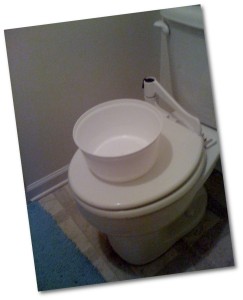My mom said she got foodborne illness a couple of years ago, and it affected her for over a year.
 She didn’t contact the health unit and didn’t go the hospital, because that’s how we roll.
She didn’t contact the health unit and didn’t go the hospital, because that’s how we roll.
My mom’s like most people I chat with about poop: it’s sorta embarrassing. It’s nerds like Chapman (his kit, right) that get stool samples and find out they’re part of a state-wide outbreak.
The U.S. Centers for Disease Control reports that increased availability and rapid adoption of culture-independent diagnostic tests (CIDTs) is moving clinical detection of bacterial enteric infections away from culture-based methods. These new tests do not yield isolates that are currently needed for further tests to distinguish among strains or subtypes of Salmonella, Campylobacter, Shiga toxin–producing Escherichia coli, and other organisms.
Public health surveillance relies on this detailed characterization of isolates to monitor trends and rapidly detect outbreaks; consequently, the increased use of CIDTs makes prevention and control of these infections more difficult (1–3). During 2012–2013, the Foodborne Diseases Active Surveillance Network (FoodNet*) identified a total of 38,666 culture-confirmed cases and positive CIDT reports of Campylobacter, Salmonella, Shigella, Shiga toxin–producing E. coli, Vibrio, and Yersinia. Among the 5,614 positive CIDT reports, 2,595 (46%) were not confirmed by culture. In addition, a 2014 survey of clinical laboratories serving the FoodNet surveillance area indicated that use of CIDTs by the laboratories varied by pathogen; only CIDT methods were used most often for detection of Campylobacter (10%) and STEC (19%).
Maintaining surveillance of bacterial enteric infections in this period of transition will require enhanced surveillance methods and strategies for obtaining bacterial isolates.
Bacterial enteric infections detected by culture-independent diagnostic tests — FoodNet, United States, 2012–2014
CDC MMWR March 13, 2015 / 64(09);252-257
Martha Iwamoto, Jennifer Y. Huang,. Cronquist, Carlota Medus, Sharon Hurd, Shelley Zansky, John Dunn, Amy M. Woron, Nadine Oosmanally, Patricia M. Griffin, John Besser, Olga L. Henao
http://www.cdc.gov/mmwr/preview/mmwrhtml/mm6409a4.htm?s_cid=mm6409a4_w
